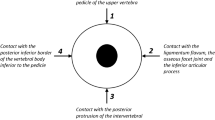Abstract
Purpose
Clinical evaluation of lumbar foraminal stenosis typically includes qualitative assessments of perineural epidural fat content around the spinal nerve root and evaluation of nerve root impingement. The present study investigates the use of several morphological MRI-derived metrics as quantitative predictors of foraminal stenosis grade.
Methods
62 adult patients that underwent lumbar spine MRI evaluation over a 1-month duration in 2018 were included in the analysis. Radiological gradings of stenosis were captured from the existing clinical electronic medical record. Clinical gradings were recorded using a 0–5 scale: 0 = no stenosis, 1 = mild stenosis, 2 = mild-moderate stenosis, 3 = moderate stenosis, 4 = moderate-severe stenosis, 5 = severe stenosis. Quantitative measures of perineural epidural fat volume, nerve root cross-sectional area, and lumbar pedicle length were derived from T1 weighted sagittal spine MRI on each side of all lumbar levels. Spearman correlations of each measured metric at each level were then computed against the stenosis gradings.
Results
A total of 347 volumetric segmentation and radiological foraminal stenosis grade sets were derived from the 62-subject study cohort. Statistical analysis revealed significant correlations (p < 0.001) between the volume of perineural fat and stenosis grades for all lumbar vertebral levels.
Conclusion
The results of the study have demonstrated that segmented volumes of perineural fat predict the severity of clinically scored foraminal stenosis. This finding motivates further development of automated perineural fat segmentation methods, which could offer a quantitative imaging biometric that yields more reproducible diagnosis, assessment, and tracking of foraminal stenosis.


Similar content being viewed by others
Data availability
The data that support the findings of this study are available from the corresponding author upon reasonable request.
Code availability
Not Applicable.
References
Jeong TS, Ahn Y, Lee SG, Kim WK, Son S, Kwon JH (2017) Correlation between MRI grading system and surgical findings for lumbar foraminal stenosis. J Korean Neurosurg Soc 60:465–470. https://doi.org/10.3340/jkns.2016.1010.004
Jenis L, An H (2000) Spine update: lumbar foraminal stenosis. Spine 25:389–394. https://doi.org/10.1097/00007632-200002010-00022
Porter R, Hibbert C, Evans C (1984) The natural history of root entrapment syndrome. Spine 9:418–421. https://doi.org/10.1097/00007632-198405000-00017
Lee S, Lee JW, Yeom JS et al (2010) A practical MRI grading system for lumbar foraminal stenosis. AJR Am J Roentgenol 194:1095–1098. https://doi.org/10.2214/AJR.09.2772
Hasegawa T, An HS, Haughton VM, Nowicki BH (1995) Lumbar foraminal stenosis: critical heights of the intervertebral discs and foramina: a cryomicrotome study in cadavera. J Bone Joint Surg Am 77:32–38. https://doi.org/10.2106/00004623-199501000-00005
Chang SB, Lee SH, Ahn Y, Kim JM (2006) Risk factor for unsatisfactory outcome after lumbar foraminal and far lateral microdecompression. Spine 31:1163–1167. https://doi.org/10.1097/01.brs.0000216431.69359.91
Shim YJ, Ha HG, Lee JS, Kim YS, Park MS, Kim JS (2000) Microsurgical decompression for lumbar stenosis via unilateral laminotomy. J Korean Neurosurg Soc 29:1505–1513
Attias N, Hayman A, Hipp JA, Noble P, Esses SI (2006) Assessment of magnetic resonance imaging in the diagnosis of lumbar spine foraminal stenosis–a surgeon’s perspective. J Spinal Disord Tech 19:249–256. https://doi.org/10.1097/01.bsd.0000203942.81050.c8
Glen WV (1982) Tomography multiplaner reformatted (CT/MRI) examination of the lumbar spine. University of California Printing Department 87
Speciale AC, Pietrobon R, Urban CW et al (2002) Observer variability in assessing lumbar spinal stenosis severity on magnetic resonance imaging and its relation to cross-sectional spinal canal area. Spine 27:1082–1086. https://doi.org/10.1097/00007632-200205150-00014
Kunogi J, Hasue M (1991) Diagnosis and operative treatment of intraforaminal and extraforaminal nerve root compression. Spine 16:1312–1320. https://doi.org/10.1097/00007632-199111000-00012
Wildermuth S, Zanetti M, Duewell S et al (1998) Lumbar spine: quantitative and qualitative assessment of positional (upright flexion and extension) MR imaging and myelography. Radiology 207:391–393. https://doi.org/10.1148/radiology.207.2.9577486
Funding
No funding was received for conducting this study.
Author information
Authors and Affiliations
Contributions
All authors contributed to the study conception and design. Material preparation, data collection and analysis were performed by VG, DH and KK. The first draft of the manuscript was written by VG and KK and all other authors commented on previous versions of the manuscript. All authors read and approved the final manuscript.
Corresponding author
Ethics declarations
Conflict of interest
The authors declare that they have no conflict of interest.
Consent to participate
The study was performed through a retrospective clinical data review protocol approved by the local Institutional Review Board under a waiver of consent. All data collected within the study was extracted from the clinical record and there was no study-oriented interaction with any study subjects. A waiver from the local IRB can be provided if requested.
Ethical approval
Ethical approval was waived by the local Ethics Committee of the Medical College of Wisconsin in view of the retrospective nature of the study and all the procedures being performed were part of the routine care.
Additional information
Publisher's Note
Springer Nature remains neutral with regard to jurisdictional claims in published maps and institutional affiliations.
Rights and permissions
About this article
Cite this article
Gunasekaran, V.S., Hejdak, D., Meyer, B. et al. Quantitative correlation of lumbar foraminal stenosis with local morphological metrics. Eur Spine J 30, 3319–3323 (2021). https://doi.org/10.1007/s00586-021-06944-8
Received:
Revised:
Accepted:
Published:
Issue Date:
DOI: https://doi.org/10.1007/s00586-021-06944-8




